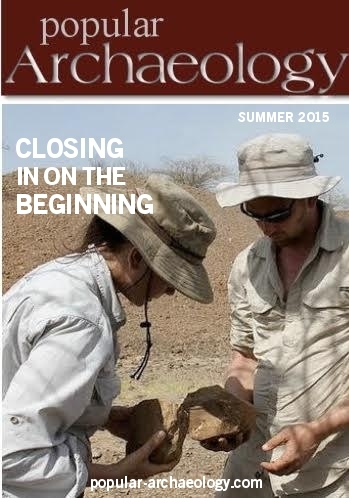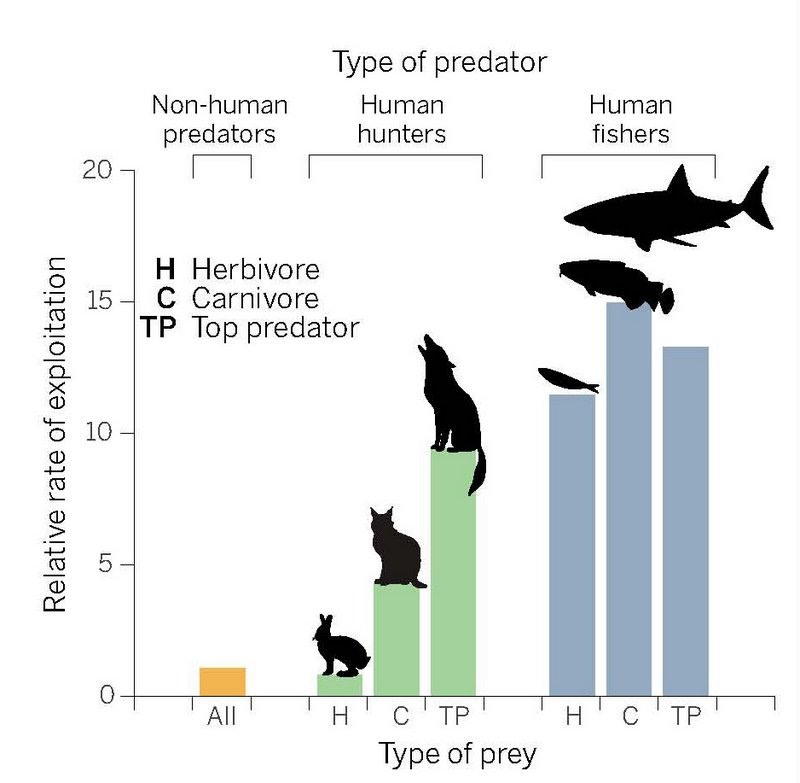
Many decades of scientific research and archaeological excavations have produced a wealth of data, in the form of fossils, artifacts, and the resulting information and insights they have afforded, about a human genus that, for the better part of over two million years, scavenged, hunted, foraged and fished for a living. Museum dioramas depict small groups of hardy, spear- and bow-and-arrow equipped hunting parties bringing down Ice Age megafauna like the woolly mammoth or other giant Ice Age mammals in North America or Eurasia. Artists illustrate early human groups with stone hand axes slicing up scavenged or hunted lion prey on the African savannah a million years ago in what is today Kenya or Tanzania. Past studies have suggested that many vulnerable species that thrived in land areas occupied by humans over the past 40,000 years have gone extinct, at least in part due to exploitation by cooperative human hunter-gatherers who, because of their cultural and technological evolution, were able to successfully prey upon larger animals and a more diverse faunal set.
But legions of past human hunters notwithstanding, none of them can compare to the human “super predator” of today.
Such might be the conclusion of anyone reading a recent study published in the journal Science by Chris Darimont and colleagues of the University of Victoria. In that study, Darimont and his team conducted a survey of 399 animal species for a total of 2,125 estimates combining both terrestrial and marine environments across the globe. What they found was a predominant human pattern of preying on adults of other species at rates up to 14 times higher than other predators, with especially focused exploitation of terrestrial carnivores and fishes.
“We reveal striking differences in exploitation rates between nonhuman predators and contemporary humans, particularly fishers and carnivore hunters,” report Darimont, et al. “Clearly, nonhuman predators influence prey availability to humans. But overwhelmingly these consumers target juveniles, the reproductive “interest” of populations. In contrast, humans—released from limits other predators encounter—exploit the “capital” (adults) at exceptionally higher rates,” the authors continued.* Our dominance is most pronounced in the marine environment—the oceans—they maintain.
“Our wickedly efficient killing technology, global economic systems and resource management that prioritize short-term benefits to humanity have given rise to the human super predator,” says Darimont, also science director for the Raincoast Conservation Foundation.
__________________________________________
Horned animals with human hunters in late bronze age petroglyph at Tangaly, Kazakhstan. Ken and Nyetta, Wikimedia Commons
__________________________________________
Above: Wildlife under pressure. Darimont et al. show that the rates at which humans exploit land mammals and marine fish vastly exceeds the impacts of other predators. Marine fish experience “fishing through marine food webs,” with diiferent trophic groups similarly affected. In contrast, on land top predators are exploited at much higher rates than are herbivores. Courtesy P. Huey/ Science
_____________________________________________________________
But the biggest story may be the potential consequences. The authors point to the impact it is having and will continue to have on the current and future global ecosystems and environment, a subset of which could be the eventual extinction of the prey humans target.
“Our impacts are as extreme as our behaviour and the planet bears the burden of our predatory dominance,” says Darimont.
Write the authors in the report: “The implications that can result are now increasingly costly to humanity, and add new urgency to reconsidering the concept of sustainable exploitation.”*
Will we be the victims of our own evolutionary success in this sense, or could we as a species successfully adapt our behavior and conserve the current ecosystem? Boris Worm, in a related article published in the same issue of Science, makes some concluding statements about the insights we have gained from this study and other similar studies that have preceded it. One of them stands out in relation to Darimont, et al.’s conclusions. Compared to all other predators, “we have the unusual ability to analyze and consciously adjust our behavior to minimize deleterious consequences.”**
Time will tell the story.
_______________________________________________________
*”The unique ecology of human predators,” by C.T. Darimont; C.H. Fox; H.M. Bryan; T.E. Reimchen at University of Victoria in Victoria, BC, Canada; C.T. Darimont; C.H. Fox; H.M. Bryan at Raincoast Conservation Foundation in Sidney, BC, Canada; C.T. Darimont; H.M. Bryan at Hakai Institute in Heriot Bay, BC, Canada. 21 August 2015, Vol. 349, Issue 6250.
**”A most unusual (super) predator,” by Boris Worm, Science, 21 August 2015, Vol. 349, Issue 6250.
Additional content adapted and edited from the related University of Victoria news release.
_______________________________________________________
 Read more in-depth articles about archaeology with a premium subscription to Popular Archaeology Magazine.
Read more in-depth articles about archaeology with a premium subscription to Popular Archaeology Magazine.
In addition, the latest Popular Archaeology ebook is now available.
______________________________________________
Travel and learn with Far Horizons.
____________________________________________
 This richly illustrated ebook version of a recent Popular Archaeology issue includes the following stories: The discovery of the tomb of a previously unknown pharaoh that is shedding light on a lost ancient Egyptian dynasty; how genetics is revolutionizing what we know about human evolution and our prehistoric past; one scholar’s controversial ‘New Chronology’ and how it supports the historicity of the biblical Exodus; how archaeologists are unearthing new history in Williamsburg, Virginia, a seat of British colonial power in 18th century America; the discovery of the remains of a major Roman legionary base in Israel; the unearthing of an ancient Judean fortified settlement in the borderlands between the biblical kingdoms of ancient Judah and the Philistines; and how archaeologists are uncovering evidence of what may have been an important administrative center of Judah during the 8th century BCE. Now available from Amazon.com!
This richly illustrated ebook version of a recent Popular Archaeology issue includes the following stories: The discovery of the tomb of a previously unknown pharaoh that is shedding light on a lost ancient Egyptian dynasty; how genetics is revolutionizing what we know about human evolution and our prehistoric past; one scholar’s controversial ‘New Chronology’ and how it supports the historicity of the biblical Exodus; how archaeologists are unearthing new history in Williamsburg, Virginia, a seat of British colonial power in 18th century America; the discovery of the remains of a major Roman legionary base in Israel; the unearthing of an ancient Judean fortified settlement in the borderlands between the biblical kingdoms of ancient Judah and the Philistines; and how archaeologists are uncovering evidence of what may have been an important administrative center of Judah during the 8th century BCE. Now available from Amazon.com!
____________________________________________








